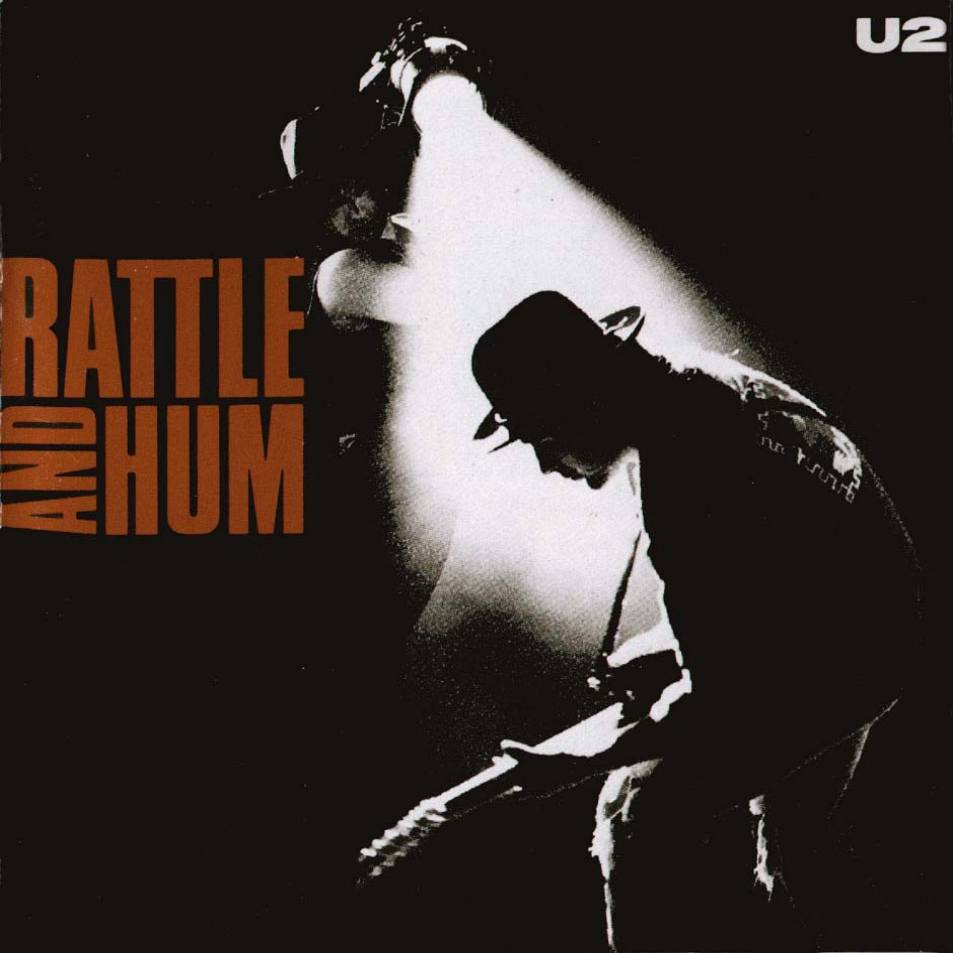
Rattle and Hum (1989)

1. Helter Skelter 2. Van Diemen's Land 3. Desire 4. Hawkmoon 269 5. All Along the Watchtower 6. I Still Haven't Found What I'm Looking For 7. Freedom For My People 8. Silver and Gold 9. Pride (In the Name of Love) 10. Angel of Harlem 11.Love Rescue Me 12.When Love Comes To Town 13.Heartland 14.God Part 2 15.The Star Spangled Banner 16.Bullet the Blue Sky 17.All I Want Is You
What do The Beatles, Bob Dylan, Elvis Presley, Jimi Hendrix, B.B. King, Billie Holiday, and John Lennon all have in common? Well, for one thing, they all manage to show up—directly or indirectly—on U2’s sprawling and ambitious hybrid release, Rattle and Hum. That should give you some sense of the scale and intent behind this project. Coming off the seismic success of The Joshua Tree, U2 did what so many conquering bands have done before: they looked outward, deep into the heart of America, and made a film and album documenting the journey.
On paper, the concept seems bulletproof. A part-documentary, part-concert film charting their American tour, with an accompanying record that blends live performances with brand new studio material. In execution, however, the results are less cohesive. The movie, though not without its strengths, occasionally buckles under the weight of its own ambitions. The band—now global icons—opt to cast themselves more as observers of American culture than participants, layering their music with weighty socio-political commentary. It's a noble effort, and perhaps even necessary considering the thematic concerns of The Joshua Tree, but it sometimes comes at the cost of spontaneity.
The accompanying album fares similarly. Rattle and Hum is many things—part live album, part studio LP, part historical homage—but unified it is not. There’s no logical arc tying the material together. Five live cuts appear almost arbitrarily—among them covers of All Along the Watchtower and Helter Skelter, the latter famously introduced by Bono with the declaration, “This is a song Charles Manson stole from The Beatles—we're stealing it back.” It’s a memorable moment, no doubt, but it underscores the strange cultural scavenger hunt that the entire album seems to be on.
Elsewhere, the studio cuts show immense promise. Angel of Harlem pays tribute to Billie Holiday with brassy, Motown flair. Love Rescue Me features Bob Dylan on backing vocals. When Love Comes to Town is a full-throttle duet with B.B. King. Even the Hendrix version of The Star-Spangled Banner is shoehorned in as a dramatic intro to Bullet the Blue Sky. Add to that God Part II, which directly answers a John Lennon solo track, and you begin to feel the scope of U2’s artistic reach—bold, reverent, and maybe a bit overextended.
And that’s perhaps the central issue. As a record, Rattle and Hum tries to be too many things at once. Had it been divided—one album of polished studio cuts, another of raw live performances—it might have landed more cleanly. Instead, what we get is a fascinating but disjointed collection that doesn’t quite know what it wants to be.
To be clear, the individual songs are often excellent. This is still U2, after all, and even in their most tangled state, the passion and talent shine through. But without a stronger guiding hand in the sequencing or editing, the album plays more like an archival scrapbook than a fully realized statement.
Critics weren’t kind. Some dismissed it as bloated and self-important (“Prattle and Dumb,” as one infamous review called it), and while that judgment is harsh, it wasn’t entirely unearned. For all its ambition, Rattle and Hum marked the moment when U2’s gravity began to outweigh their momentum. Still, it remains an essential snapshot of the band in transition—grappling with fame, mythology, and the American musical canon. If nothing else, it’s a reminder that even the biggest bands can still get a little lost on the road to greatness. And for those willing to sift through the clutter, there’s plenty of gold to be found.